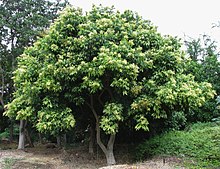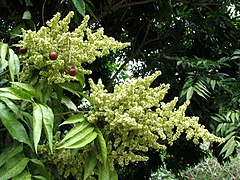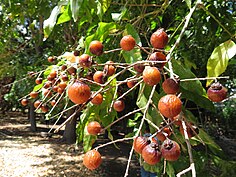
Acer campestre, known as the field maple, is a flowering plant species in the family Sapindaceae. It is native to much of continental Europe, Britain, southwest Asia from Turkey to the Caucasus, and north Africa in the Atlas Mountains. It has been widely planted, and is introduced outside its native range in Europe and areas of USA and Western Australia with suitable climate.

Cercocarpus, commonly known as mountain mahogany, is a small genus of at least nine species of nitrogen-fixing flowering plants in the rose family, Rosaceae. They are native to the western United States and northern Mexico, where they grow in chaparral and semidesert habitats and climates, often at high altitudes. Several are found in the California chaparral and woodlands ecoregion.

Conocarpus erectus, commonly called buttonwood or button mangrove, is a species of mangrove shrub in the family Combretaceae. It grows on shorelines in tropical and subtropical regions around the world.

Sphaeropteris cooperi, synonym Cyathea cooperi, also known as lacy tree fern, scaly tree fern, or Cooper's tree fern, is a tree fern native to Australia, in New South Wales and Queensland.
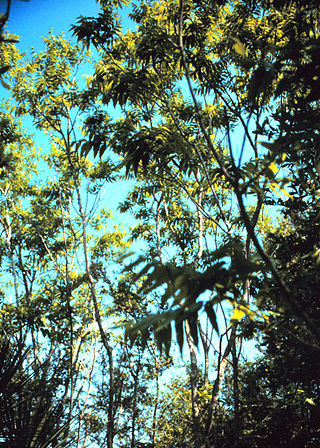
Sapindus is a genus of about five to twelve species of shrubs and small trees in the lychee family, Sapindaceae, native to warm temperate to tropical regions of the world. The genus includes both deciduous and evergreen species. Members of the genus are commonly known as soapberries or soapnuts because the fruit pulp is used to make soap. The generic name is derived from the Latin words sapo, meaning "soap", and indicus, meaning "of India".

Coprosma is a genus of flowering plants in the family Rubiaceae. It is found in New Zealand, Hawaiian Islands, Borneo, Java, New Guinea, islands of the Pacific Ocean to Australia and the Juan Fernández Islands.

Abies lasiocarpa, the subalpine fir or Rocky Mountain fir, is a western North American fir tree.
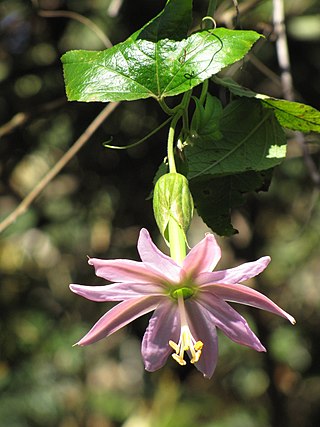
Passiflora tarminiana is a species of passionfruit. The yellow fruits are edible and their resemblance to small, straight bananas has given it the name banana passionfruit in some countries. It is native to the uplands of tropical South America and is now cultivated in many countries. In Hawaii and New Zealand it is now considered an invasive species. It was given the name banana passionfruit in New Zealand, where passionfruit are also prevalent. In Hawaii, it is called banana poka. In its Latin American homeland, it is known as curuba, curuba de Castilla, or curuba sabanera blanca (Colombia); taxo, tacso, tagso, tauso (Ecuador); parcha, taxo (Venezuela), tumbo or curuba (Bolivia); tacso, tumbo, tumbo del norte, trompos, tintin or purpur (Peru).

Acer spicatum, the mountain maple, dwarf maple, moose maple, or white maple, is a species of maple native to northeastern North America from Saskatchewan to Newfoundland, and south to Pennsylvania. It also grows at high elevations in the southern Appalachian Mountains to northern Georgia.
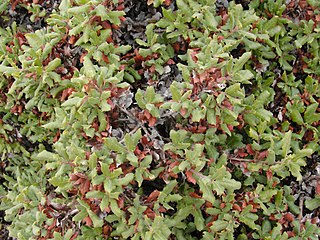
Quercus durata, commonly known as leather oak, is a species of oak endemic to California, common in the Coast Ranges and the foothills of the Sierra Nevada. The common name "leather oak" is derived from the leathery texture on the lop of its leaves. Taxonomically it is placed in the white oak group.

Terminalia chebula, commonly known as black- or chebulic myrobalan, is a species of Terminalia, native to South Asia from Pakistan, India and Nepal east to southwest China (Yunnan), and south to Sri Lanka, Malaysia, and Vietnam.

Prunus subcordata, known by the common names Klamath plum, Oregon plum, Pacific plum and Sierra plum, is a member of the genus Prunus, native to the western United States, especially California and Oregon.

Araucaria columnaris, the coral reef araucaria, Cook pine, New Caledonia pine, Cook araucaria, or columnar araucaria, is a species of conifer in the family Araucariaceae.

Hibiscadelphus giffardianus is a species of flowering plant in the mallow family Malvaceae that is endemic to the Big Island of Hawaii.

Alectryon macrococcus, known as ʻAlaʻalahua or Māhoe in Hawaiian, is a slow-growing flowering tree in the soapberry family, Sapindaceae, that is endemic but manifests rarely in mesic forests of Kauai, Oahu, Molokai, and Maui Hawaii. The tree grows to a maximal height of about 10 meters with leaves 3 to 30 cm long with two to five pairs of elliptic pinnae. The pinnae are smooth, glossy and net-veined, 4 to 10 inches long and 2 to 5 inches. Fruits are from 1 to 3 inches in diameter with a single black seed embedded in a red, fleshy aril. More than a century ago, it was noted that Hawaiians ate the fleshy, insipid and slightly sweet arils and mildly flavored seeds.

Sapindus oahuensis is a species of tree in the soapberry family, Sapindaceae. It is endemic to Hawaii, where it is limited to Kauaʻi and Oʻahu. Its common names include Āulu, Oahu soapberry, alulu, kaulu, and lonomea.

Isocoma menziesii is a species of flowering plant in the family Asteraceae, known by the common name Menzies' goldenbush.

Sapindus mukorossi, commonly known as Indian soapberry, washnut, ritha or Chinese soapberry, is a species of tree in the family Sapindaceae. It is a deciduous tree that grows in the lower foothills and midhills of the Himalayas at altitudes of up to 1,200 metres (4,000 ft). It is also native to western coastal Karnataka, Maharashtra, and Goa in India; as well as southern China, and Taiwan as known by its many indigenous peoples. It is tolerant to reasonably poor soil, can be planted around farmers’ homes, and one tree can produce 30 to 35 kilograms of fruit per year.
Sullucullahua is a mountain in the Chila mountain range in the Andes of Peru, about 5,200 m (17,060 ft) high. It is located in the Arequipa Region, Castilla Province, Chachas District. Sullucullahua lies northeast of Chinchón and Aceruta and southeast of Huanca.

Sapindus marginatus, the Florida soapberry, is native to Georgia, Florida and South Carolina. It grows as a small to medium-sized small tree that usually grows to 30 feet (9.1 m) tall. It has pale gray or brown, ridged bark. The leaves are up to 1 foot (0.30 m) foot long with 6 to 13 leaflets. The leaflets are 2 to 6 inches long and .75 to 2.75 inches wide, and have pointed tips with no teeth on the edges. The leaflets may be opposite or alternate. The leaves fall in the early spring.
